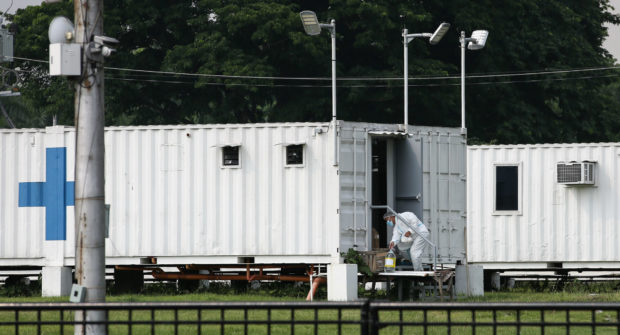Another ‘peak’ in COVID cases starting – DOH

A health worker wearing a PPE suit brings inside some food and drinks left by the doorstep of a wing at the Manila COVID-19 Field Hospital in Manila. Metro Manila remains under low-risk classification for COVID-19 according to the Department of Health. (Photo by LYN RILLON / Philippine Daily Inquirer)
MANILA, Philippines — The Department of Health (DOH) on Monday said the country was seeing the start of another “peak” in COVID-19 cases and urged the public to observe health protocols, including isolating when experiencing COVID-19 symptoms.
Detected infections rose by 82 percent to 436 daily average new cases last week—the highest in about two months—from 240 the previous week, according to the DOH.
“Right now what we’re seeing is that the number of cases is continuously increasing, especially here in the National Capital Region (NCR) and we can see that this is really the start of the peak in the number of cases,” Health Undersecretary Maria Rosario Vergeire said in a television interview on Monday.
“We are again guiding the public and making them aware that this might be the start when cases will continuously increase in the next couple of weeks,” she added.
Vergeire refused to refer to the increasing cases as a “surge,” saying the term “has caused a lot of confusion among the public.”
Unlikely shift
However, it is unlikely that Metro Manila’s alert level classification will shift to moderate risk even if several of its cities recently recorded rising infections.
Infectious disease expert Dr. Edsel Salvana said NCR was “very far” from the metrics that would merit a transition to the stricter alert level 2.
“We are very far from the parameters that the Department of Health uses in terms of moving from low risk to moderate risk,” Salvana, a consultant of the government’s COVID-19 task force, said during Monday’s Laging Handa briefing.
These factors include the average daily attack rate and the health-care utilization rate, which he said should be above the 50-percent mark for moderate risk classification.
Citing the World Health Organization, Salvana said there should be around 800 cases every day in Metro Manila for the next two weeks to merit a shift in the alert level.
“Also, the hospital utilization rate should be above 50 percent. We are now at the low 20 percent,” he added.
The adviser of the Inter-Agency Task Force for the Management of Emerging Infectious Diseases said COVID-19 vaccines received by patients helped reduce the risk of hospitalization.
“The vaccination rates are really keeping the number of hospitalizations very low. Even if the actual number of cases go up, the number of people who need urgent or acute medical care in the hospitals is very, very low,” Salvana said.
Of the 3,051 confirmed cases last week, only 15 were severe and critical.
Another factor is the continued use of face masks despite the low risk classification in many regions, which also helped limit the spread of the virus, he said.
RELATED STORIES
COVID-19 cases rising but surge still preventable – DOH
Uptick in COVID-19 cases should not alarm public, says Concepcion
If uptick continues, COVID-19 cases may hit 1,200 daily by end-June — DOH